Periodicals
Periodicals

Starship 20
Contributors to Starship № 20:
Rosa Aiello, Terry Atkinson, Tenzing Barshee, Gerry Bibby, Mercedes Bunz, David Bussel, Jay Chung, Eric D. Clark, Caleb Considine, Hans-Christian Dany, Albert Dichy, Nikola Dietrich, Martin Ebner, Ruth Angel Edwards, Stephanie Fezer, Jean Genet, Simone Gilges, Julian Göthe, Michèle Graf, Selina Grüter, Ulrich Heinke, Toni Hildebrandt, Beatrice Hilke, Karl Holmqvist, Stephan Janitzky, G. Peter Jemison, Charlotte Johannesson, Julia Jost, Julia Jung, Jakob Kolding, Nina Könnemann, Lars Bang Larsen, Anita Leisz, Norman Lewis, Elisa R. Linn, Sebastian Lütgert, Vera Lutz, Chloée Maugile, Robert McKenzie, Ariane Müller, Christopher Müller, Robert M. Ochshorn, Henrik Olesen, Kari Rittenbach, Nina Rhode, Ulla Rossek, Cameron Rowland, Mark von Schlegell, Ryan Siegan Smith, Philipp Simon, Valerie Stahl Stromberg, Josef Strau, Vera Tollmann, Eleanor Ivory Weber, Camilla Wills, Amelie von Wulffen and Florian Zeyfang.
"This is the 20th issue of Starship and we are proud and very happy to present it, and mainly want to thank all the artists, the contributors, the columnists, and the people who helped us gather images of exhibitions past, and gave us texts from books not yet published. Starship never starts with a clear concept about its future content, or what could be called a theme, but always with a sort of attentive interest. The theme may develop through its columnists—we now think it is easy to distinguish lines of thoughts, images, and texts answering each other. But it surely does so out of this editorial interest that wanders, and finds, and collects, is enthusiastic about artworks, and texts, and people, and then, well, brings this all together in a magazine. This was our working mode during the past year, and the responsiveness of those who regularly write for Starship (the columnists) has shown us that out there others are involved in thoughts that run very much in parallel. It is a strange form, a magazine like this, not getting funded, appearing irregularly, but still following a sort of conventional form that shows its consistency. It is at its core an excess of producing something that might prove itself valuable and liberating in the future."
—Ariane Müller, Henrik Olesen

Sore 2
Sore is a serial anthology that brings together authors whose writing practices oscillate between the genres of diary keeping and fiction. For the second issue of Sore, ten contributors – both authors and visual artists – were invited to collectively develop their work through a series of informal critiques over the course of five months.
In the first issue of Sore, observations of everyday life intertwined with memories and cultural references to denote the significance of a certain soreness we each carry within us as we negotiate the various challenges of social existence. In this second ensemble, seven new authors widen our understanding of the term ‘sore’ by underlining a need to orient one’s gaze towards what’s hidden underneath, to enter the anatomy of all these necessary contortions and u-turns one performs in order to escape the grip of expected compliance.
With contributions from: Mathilde Heuliez, Lisa Lagova, Muyeong Kim, Nour Ben Saïd, Masha Ryabova, Adrienne Chung, Richard Dmitri Hees, Oscar Le Merle, Morra Kozlitina, Tindra Eliason, Helmer Stuyt, Ilya Stasevich, Kristina Stallvik.
Published by cover crop, Mathilde Heuliez & Lisa Lagova.

GLEAN - Issue 5 (ENG edition)
Guest editor: Orla Barry, City Report Brussels: Maxime Fauconnier and Natural Contract Lab, Kasper König, Kendell Geers, Lucy McKenzie, Nástio Mosquito, Lisa Vlaemminck, Paloma Bosquê, Joar Nango, Sandrine Colard, Wu Tsang, Busan Biennale
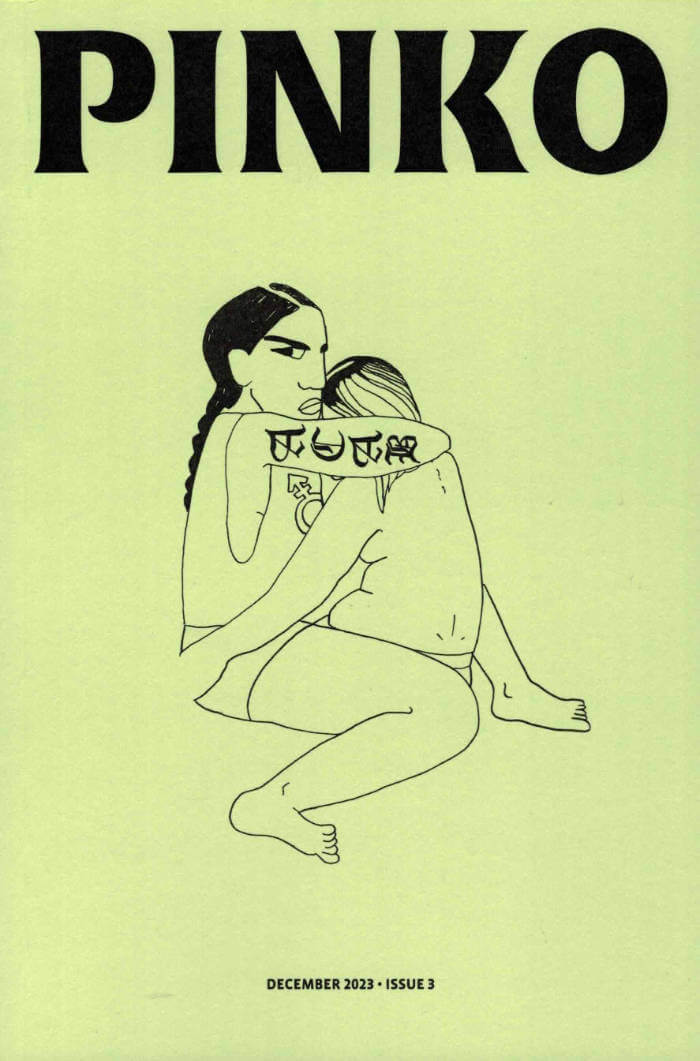
Pinko Magazine Issue 3
This third print issue contains Pinko's editorials on trans eradication and Palestinian survival, essays about black lesbian sex writing, consent and its limits, the end of sexual liberalism, and a presentation of imbrication theory, plus a roundtable on political violence, an interview from Pinko's book After Accountability, and a memorial to the gay socialist publisher Jeffrey Escoffier. Illustrations by the artist KT Pe Benito grace this issue.

Pinko Magazine Issue 2
This second print issue contains an interview with the abolitionist organizer Stevie Wilson, essays about nineties nightlife in support of queer intimacies in Santiago, Chile, Barbz against pinkwashing, a translation of the communization theorist Gilles Dauvé’s latest work on the reactionary tendencies in the sexual liberation movement in Weimar Germany, a missive by Samuel R. Delany, a ritual script by Lou Cornum, a meditation on intersex experiences as the untheorized marrow of trans liberation, and more. There are also world-building drawings by the artist Chitra Ganesh throughout.

Issue 9: John Akomfrah
This special, limited-edition issue of Plaster celebrates Akomfrah’s commission for the British Pavilion at the 60th International Art Exhibition, La Biennale di Venezia. The linen presentation box contains: an essay by Akomfrah’s long-time friend and collaborator, the BAFTA-winning film curator June Givanni; an interview with Akomfrah by Harriet Lloyd-Smith; original portraits by photographer Siam Coy and a fold-out poster featuring an exclusive still from Akomfrah’s film installation, Listening All Night To The Rain, now screening in the British Pavilion at the Venice Biennale.
With creative direction by Constantine // Spence and design by Emma Ralph.
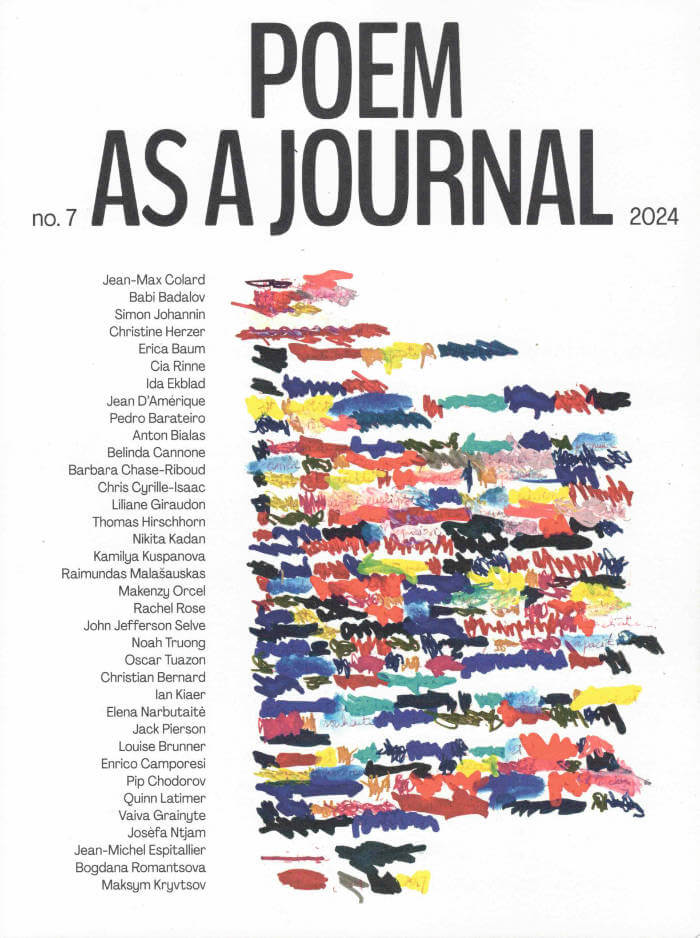
Issue 7: Poem as a Journal
What sparked off this issue of as a Journal was the clear evidence of poetry’s growing presence in the field of contemporary art. Rather than ‘Poetry’ in general, and even less so the figure of the ‘Poet’, it’s the poem that has our full attention: I find it in the title of an exhibition by Jason Dodge, on the invitation card sent out by artist Ida Ekblad, and then again in the form of an exhibition, in the display and arrangement of works within a space by Ian Kiaer, Elena Narbutaitė or Wolfgang Tillmans. Hence this open-ended question, ‘What is poetry for you today?’, placed like a probe among various art world players, in a sort of vox populi.
And so rises the confirmation of an intuition: in an art field driven by the market, where artworks are becoming luxury accessories for the jet set, poetry, with its poverty and economy of means, appears at the opposite end of the spectrum, as a pole of resistance.
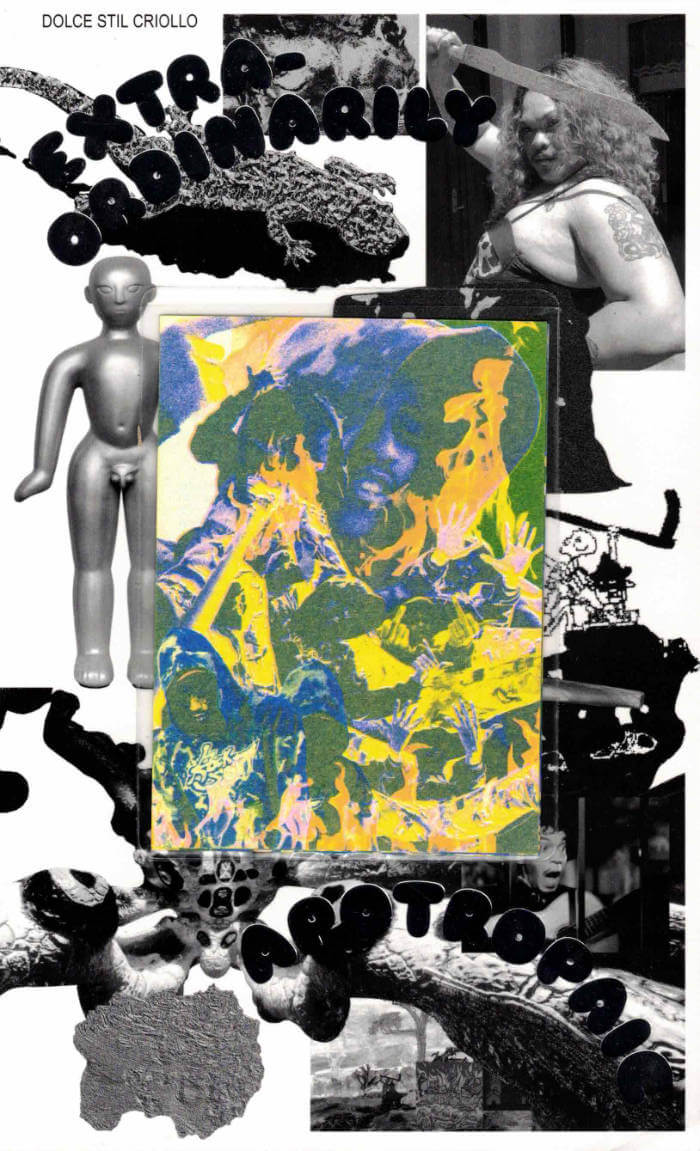
Dolce Stil Criollo Issue 5: Extraordinarily Apotropaic
Dolce Stil Criollo’s fifth issue, "Extraordinarily Apotropaic," aims to rethink reality in its current ordinary form by discovering and creating charms and rituals for changing it into one where there is less harm. The issue features poems in multiple languages; a map of dreams; a video game-turned-manga; a section that functions as a kineograph; a collaboration with the Huni Kuin people; and more. We also curated a collective project, “Cinema of Hope,” which brings together 11 moving image artists in search of the apotropaic moment, caught on film.
The cover of our fifth issue features one of five “santinho” inserts. Designed like prayer cards, they contain a collaged portrait of a musical artist (Pivaratu, Pivete Nobre, Iya, Swatch, Devil Gremory) on the recto and the rap lyrics they wrote in response to our theme on the verso.
Contributors include Andrés-Monzón Aguirre, Aykan Safoğlu, Azul Caballero Adams, Belinda Zhawi, Daniel Machado, Daniel Moura, Devil Gremory, Enorê, Esvin Alarcón Lam, Gabriel Massan, Hick Duarte, Itamar Alves, Iya, Jennifer Pérez, Jesse Cohen, Johan Mijail, Juan Pablo Villegas, Kasra Jallilipour, Kent Chan, Keratuma (Mileidy Domicó), Laura Huertas Millán, Lucía Melií, Lucía Reissig & Bernardo Zabalaga, Maria Thereza Alves, Masha Godovannaya, Mayada Ibrahim, Najlaa Eltom, NIna Djekić, Ophelia S. Chan, Pivaratu, Pivete Nobre, Ricardo Pinheiro (Ganso), Roberto Tejada, Sofía Córdova, Sofía Gallisá Muriente, Swatch, Thales Pessoa, and Thiago Martins de Melo.
Languages: Spanish, Portuguese, English, Japanese and Arabic

The Lip Anthology: An Australian Feminist Arts Journal 1976–1984
Lip Magazine was self-published by women in Melbourne from 1976 to 1984 and stood as a lightning rod for Australian feminist artistic practice throughout the Women’s Liberation era. The art and ideas expressed over Lip’s lifetime track groundbreaking moves in performance, ecology, social-engagement and labour politics—all at an intersection with local realities. Collecting and presenting the materials of Lip for the first time since their original appearance, The Lip Anthology, edited by Vivian Ziherl, privileges the range and dynamism of contesting feminisms that comprised the Lip project.
Designed by: Marc Hollenstein

Alphabet Magazine #01
The first issue of the magazine made by artists, founded by Donatien Grau and Thomas Lenthal. Contributions by Mathias Augustyniak, Naomi Campbell, Théo Casciani, Michael Chow, Pan Daijing, Es Devlin, Claire Fontaine, Edwin Frank, Theaster Gates, Nicolas Godin, Alejandro Jodorowsky, Hedi El Kholti, Michèle Lamy, Paul McCarthy, Ian McEwan, Eileen Myles, Marc Newson, Hans Ulrich Obrist, Diana Widmaier Picasso, Ariana Reines, Barbara Chase-Riboud, Julian Schnabel & Jason Momoa, Hanna Schygulla, Juergen Teller, Iké Udé, McKenzie Wark, Robert Wilson, Yohji Yamamoto.
Alphabet is the artists' magazine. Here, they run the show. They write, they make images, they select their own works, they interview the figures they admire, they tell us what we did not know about them nor could have ever fathomed about life. This magazine is conceived entirely to put them in the driver's seat, and to enable readers to become part of the unique vision of some of today's greatest luminaries.
It is a manifestation of the creative community, coming together from all fields, from all generations and threads of culture. Writers, musicians, designers, painters, sculptors, poets—artistic figures of every kind converse all the time in their lives, but they did not have a shared space for their editorial projects. This is it.
Everyone who finds their way into Alphabet has made a mark on life, art, and culture, in a way that signals their importance to the present. Some of the contributors may be world famous, others well respected, others on the way to becoming the legends they already are. Their relevance to culture is the same, and that is why they all belong here, in the endeavor of the creative community. There is no hierarchy of status, or domain, or apparent impact. Some of the greatest revolutions happen undercover. Some of the most established voices are still breaking ground. The magazine's premise is simple: the old opposition between pop and underground does not make sense anymore. There are many creative communities, each following its own rules, each inventing its own space. Here, wherever they come from, whatever their community, artists can exist together, with the same intention of changing, and improving, what life is; with the same belief that art matters more than anything else.
None of the contributors is here randomly. They keep life thrilling and exhilarating, challenge the perception of everything and anything. Their role in shaping every aspect of life can hardly be overstated. That is why they needed a place to elaborate their own alphabet, their way of ordering and structuring language, the world, and the fabric of life—a place of freedom, where everything would be done to highlight their visions, where the very design would be a shrine to their magic. Even the distribution of the magazine was conceived with artists—each contributor suggesting sites of their liking.
Alphabet is also the magazine of magazines. Here, readers find essays, fictions, poetry, visual projects, DIY methods, recommendations from those who know, even games and astrology—and an artist's alphabet, articulating an entire universe. Anything that has ever formed a section of a magazine could find its way here. Even the cover is conceived by an artist: it was conceived especially by the legendary Robert Wilson. Artists will rejuvenate what magazines are, and magazines will be kept forever young by and with them.
Founded by Donatien Grau and Thomas Lenthal, Alphabet is a bi-yearly art magazine. Not a magazine about art. It's a magazine made by artists. Each contribution like an œuvre, making it the ultimate collector piece. Each cover is designed, with the word Alphabet, by a different artist, initiating a cult series.

Viscose 06: Text
The sixth issue of Viscose Journal focuses on fashion as constructed through words, language and writing. From the pens of fashion journalists and art critics to the conceptual wordplay of designers, the issue delves into the aesthetic and critical effects of “writing fashion” in and outside of fashion industries.
The fashion writer is a confidant, a storyteller, a forecaster, a mythmaker; they are evocative and poetic, forming words that shape, and in turn are shaped by, the latest fashions. From the salon shows to the pages of fashion magazines, their “expressions may be as ephemeral as the fashions they describe,” as Dorothy Hughes noted already in 1935. Early fashion writing played a key role in the transformation of clothes into fashion each season, and in igniting the machine of fashion itself. The historical roots of fashion writing— which was, at least in an industry context, a distinctly female practice— are grounded in the modernization and seasonalization of industrial fashion. And even today, in an age described by many as image-driven, this remains true: across various media platforms, language not only surrounds fashion but also continuously contributes to its creation.
The succinct, ephemeral poetry of the fashion writer still plays—nearly a century since Hughes’ observation—a transformative role in the seasonal turnover of fashion, but its role in the fashion industry remains seriously overlooked. Fashion invests substantially in seasonally refreshing the visual messaging accompanying its physical commodities, but language plays a similarly important support in this artful game of marketing. In this industrial context spanning from press releases to magazine production, writing is devoted to fashion promotion, prioritizing its fundamental traits of novelty, urgency, and semiotic complexity. In this context, fashion writing is a process of mystification, capable of revealing things that the image cannot. The material conditions of fashion writing—of being for fashion—generates a unique set of poetics and syntax. Fashion writing, or “written fashion,” as Roland Barthes asserts, is a form of signification that is simultaneously real and imaginary, connected to the real garment that it signifies, but largely unencumbered by its materiality. Given the constraints of economic, cultural, and political factors on fashion writing, it is perhaps more interesting to ask, what is fashion writing really encumbered by, and what would it mean to “unencumber” it?
Since Baudelaire, art critics have turned to fashion as source material for their practice, casting fashion in the role of art’s capitalist conspirator, temporal truth-sayer, or feminine alter-ego. This erratic history is one filled with both fraught politics (rooted in a gendered division of labor) as well as critical possibility: art writing gestures to a style of intellectualism and independence from industry that is largely foreign in fashion. Viscose Journal has, since its founding, aimed to detach fashion criticism from industrial frameworks that has historically premised it. At the same time, informed by a materialist politics of fashion labor, we wish to seriously level the largely female writing of commercial fashion publications with the masculine philosophical inquiries of fashion.
While “fashion writing” denotes a thematic category within the wider field of writing, our theme of “writing fashion” prompts an exploration of fashion writing as a mode of fashion production and critique. This issue aims to explore writing as a tool for shaping fashion and broaden its perspectives by presenting a survey of experimental, fictocritical, and poetic approaches to writing fashion. In this expanded field of writing, “fashion” unfolds as a ubiquitous and epistemologically complex phenomena of everyday life pertinent to all.
Accompanied by the exhibition “Writing Fashion“ at and published by the International Library for Fashion Research in Oslo, Norway, staged in June 2024, Viscose Journal 06 strives to be a thought-provoking journey into the captivating intersection of fashion and language. We are grateful to the library’s fantastic team and collaborators for their ongoing support and collaboration.
with works by: Osman Ahmed, Alba Aragón, Katherine Bernard, Ricarda Bigolin, Eileen Chang, Dal Chodha, Eduardo Costa, Jose Unzueta Criale, Femke De Vries, Becket Flannery, Kennedy Fraser, Laura Gardner, Patrick Greaney, Bruce Hainley, Elizabeth Hawes, Nakako Hayashi, Devin Hentz, Elaine Wing-Ah Ho, Juje Hsiung, Olivia Kan-Sperling, Jamaica Kinkaid, Chantal Kirby, Jeremy Lewis, Davora Lindner, Hanne Lippard, Shanzhai Lyric, Shizuang Magazine, Celine Mathieu, Derek Mccormack, H.B. Peace, Julie Peeters, John Perrault, Vogue Runway Rag, Rachel Tashjian, Jeppe Ugelvig, Elizabeth VR, Hanna Weiner, Elizabeth Wilson, Yohji Yamamoto, Bruno Zhu.

The My Comrade Anthology
The My Comrade Anthology collects pages from past issues of My Comrade selected by Linda Simpson, printed in a substantial 256-page volume on newsprint.
My Comrade was an underground gay culture zine that set itself apart from the deluge of Xeroxed zines popping up in New York in the late 1980s and early 1990s. Through parody of both mainstream tabloid magazines and the self-serious gay press, a campy and ironic sensibility, and radical left sympathies and sloganeering, My Comrade captured the zeitgeist of the gay downtown scene. Publishing 11 issues between 1987 and 1994, and three issues since, My Comrade documents the last years of underground gay culture before marriage equality and representation at elite levels of American society became the primary drivers of gay politics and aesthetic production. My Comrade was briefly revived from 2004 to 2006, and again on the occasion of the exhibition “My Comrade Magazine: Happy 35th Gay Anniversary” at Howl! in 2022.

GLEAN - Issue 4 (ENG edition)
Apparatus 22, Dak’Art, Tarek Atoui, Sirah Foighel Brutmann & Eitan Efrat, Yoko Ono, Pei-Hsuan Wang, Anna Zemánková, Sarah Smolders, Miranda July, Britta Marakatt-Labba, Ignacio Barrios
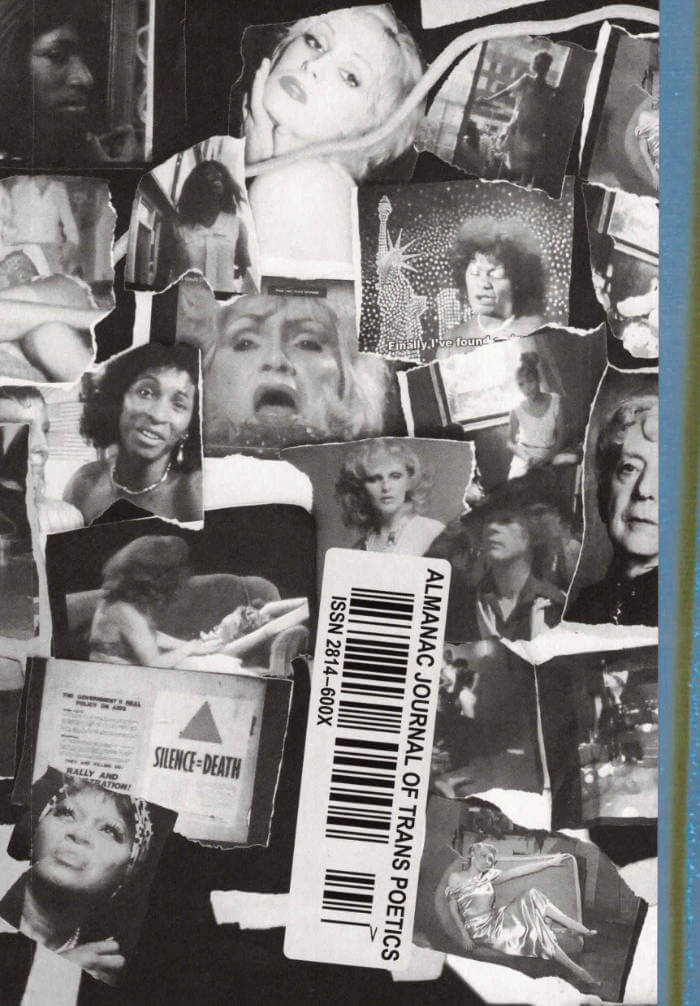
Almanac Journal of Trans Poetics: ISSUE #3 Cinema
In this issue, you’ll find different angles and takes on trans cinema. Featuring 22 contributors — the issue got pieces on gothic cinema, growing up as a TV kid in the 90s, trans femme film favs, cripness in Cronenberg’s work, love letters to the intimacy of the cinema hall and much more!
Sit back and get comfortable and let this third release take you on a journey through interviews, essays, comics, YouTube playlists, top favourite movie lists and beautiful, powerful film stills. This one is not to be missed!
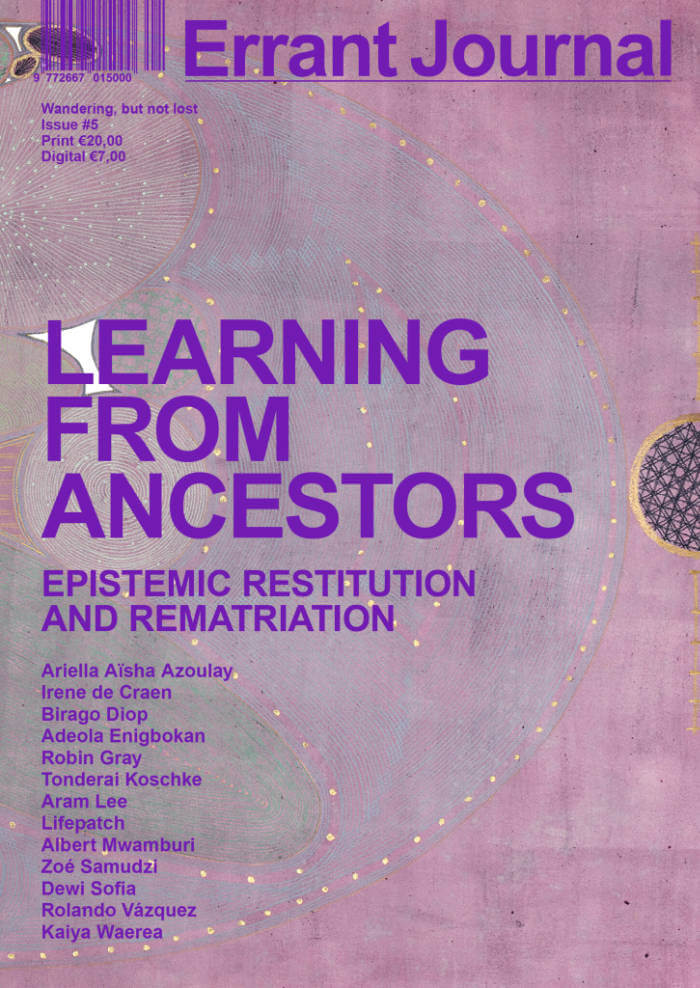
Errant Journal 5: Learning From Ancestors. Epistemic Restitution and Rematriation
Starting from the position that the return of all colonially looted, pillaged, and stolen heritage should take place in full and without hesitation, Errant Journal No. 5 ‘Learning from Ancestors’ wishes to go beyond the question of ‘giving back’, and ask what is given back by whom and to whom, where, and how? In this now seemingly omnipresent discussion, who is speaking, and which voices are being listened to? To do this, as is reflected in the title of this issue, Errant proposes a shift in perspective away from dominant (Western) epistemic authorities to consider other ways of sensing and experiencing the world and let this guide us in the questions we have. This necessarily means that this issue is not just about objects and their return, not just about physical ‘things’ that can change hands and location. It is also an issue about repair, without which restitution could be meaningless.
Contributors: Ariella Aïsha Azoulay, Irene de Craen, Birago Diop, Adeola Enigbokan, Robin Gray, Tonderai Koschke, Aram Lee, Lifepatch, Albert Mwamburi, Zoé Samudzi, Dewi Sofia, Rolando Vázquez, Kaiya Waerea

FUKT #19 – The Storylines Issue
Founded in 1999 by artist Bjørn Hegardt, FUKT, which translates to “moist” or “damp” in Norwegian and Swedish, is an annual magazine for contemporary drawing based in Berlin and Oslo. Each issue comes with a unique cover by Ariane Spanier who also co-edits and designs the magazine. From issue 16 onwards, the FUKT team began organising each edition thematically: from The Sex Issue on Dirty Drawings to The Words Issue and Fukt The System Issue.
The theme of the storyline in this edition has been interrogated in a number of ways, taking the reader on a journey from the mythical, to the sequential and the storyboard. For Hegardt, the thread that unites all of the featured artists is that “above all, they are people who create drawings with beautiful, surprising, funny or sad stories. Like always in our magazine, everything revolves around our beloved practice of drawing.
Artists: Adéla Marie Jirku, Bjørn Bjarre, Brian Rea, Byun Young Geun, Chris Ware, Colin Matthes, Danielle Morgan, Davor Gromilović, Emma Talbot, Gareth Fuller, Jana Gunstheimer, Johannes Høie, Maria Medem, Maria Paz, Marie-Louise Ekman, Miodrag Manojlović, Océane Moussé, Ori Toor, Sakubei Yamamoto, Shuvinai Ashoona, Toyin Ojih Odutola, WOSHIBAI, Yuichi Yokoyama, Xiyu Tomorrow

GLEAN - Issue 5 (NL edition)
De vijde Nederlandstalige GLEAN editie.
Bijdrages over Chantal Akerman, Biënnale van Venetië, Eline de Clercq, Samah Hijawi, Laure Prouvost, Anastasia Bay, Wim Delvoye, Riar Rizaldi, Haegue Yang, Nil Yalter, Anna Maria Mariolino.

Octopus notes #11
Baptiste Pinteaux, Martin Laborde and 1 more
The eleventh issue of the journal-collection that brings together academic writings, interviews with artists, critical essays and artists' interventions in the form of inserts.
Featuring: Madalena Anjos, Zoe Beloff, Jean-Claude Biette, Vittoria Bonifati, Christine Burgin, Moyra Davey, Migle Dulskyte, Martha, Edelheit, Hélène Giannecchini, Donna Gottschalk, Birgit Hein, Gaëlle Hippolyte, Megan Hoetger, Jacques Julien, Sophie Lapalu, Sibylle de Laurens, Anne Lefebvre, Liz Magor, Andrea Mazzella, Marlene Monteiro Freitas, Zibuntas Miksys, Vali Myers, Gaspard Nectoux, Jeffrey Perkins, Elisa Pône, James Robert Baker, João dos Santos Martins, Giovanna Scotti, Samuel Steward, Billy Sullivan, Sabrina Tarasoff, Paul Thek, and a long previously unpublished conversation (50 pages) between Paul McCarthy and Sabrina Tarasoff.
Octopus notes is a journal that gathers critical essays, academic writing, interviews, archival documents and artists' projects since 2013. Each issue exists without a theme, but shapes echo through its content.

Klima #06
Antonine Scali Ringwald, Alicia Reymond and 1 more
The sixth issue of the transversal journal, at the crossroads of art and thought, political philosophy, gender studies and academic knowledge, delves into the various forms of mutation that ripple through our world.
In biology, a mutation describes an alteration of the genetic code that spurs change in a given organism. In linguistics, it generally triggers a modification of the structure of a word, often influenced by phonetic or morphological factors. In any case, mutations—steered by some ever-changing principle—always elude the spatio-theoretical framework which they are rooted in.
Therefore, the mutations composing this issue are different from those that preceded them, and still unlike the ones that will arise in the years to come. Mutabilities explores mutations operating in various fields of research that are precious to Klima—such as ecology, contemporary art, social sciences and politics, technology, or even language. Co-edited with curator Alicia Reymond, and in collaboration with graphic design studio Espace Ness, this new issue originates from an ongoing transformation process. Mirroring an exquisite corpse, Mutabilities unveils the interventions of contributors who position forms of radical mutation at the core of their own practice. The mutations driving them not only constitute subjects for theoretical analysis, but are actually the result, the consequence, and/or the fruit of embodied reflexions. What is a mutating practice?
Edited by Loucia Carlier, Alicia Reymond, Antonine Scali Ringwald.
Contributions by Karen Barad, Léa Bouton, Patrick Chamoiseau, Emma Bigé, Salomé Burstein, David Douard, Rita Elhajj, Kim Farkas, Gözde Filinta, Eva S. Hayward, Tishan Hsu, Bhanu Kapil, Veit Laurent Kurz, Yein Lee, Lionel Manga, P. staff, Diamond Stingily, Sabrina Röthlisberger Belkacem, The School of Mutants, Sarah Shin, Olivier Zeitoun, Joanna Zylinska.
Klima is an annual magazine dedicated to contemporary creation and academic research. It aims to democratize the academic world through a conversation with the world of contemporary artistic creation. Klima gives a voice to creative, singular and conscious individuals, by relating art, activism and academia.
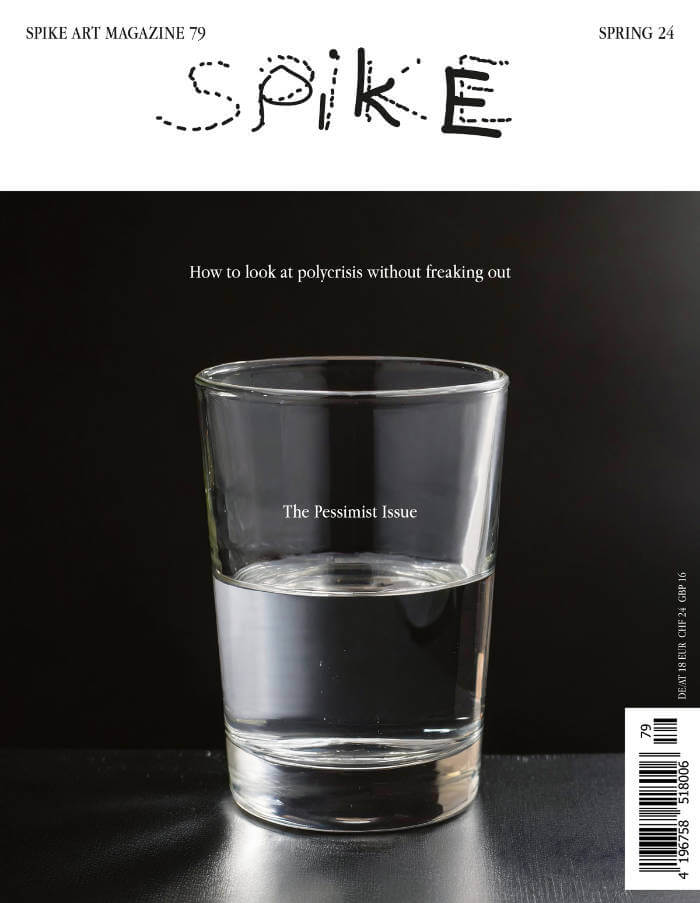
Spike #79 – The Pessimist Issue
How to look at polycrisis without freaking out.
Eco ruin and refugeeism, illiberalization and inequality, hot wars and a New Cold War—the polycrisis hydra is always growing another head. But it's also a state of mind, an identity crisis brought on by paralysis and cognitive shock. Was it always like this, but with less media reach? Or is capitalism really burning itself out, just without any redemptive zest? The arts are expert at thematizing the woes that affect them—hello, Biennale and documenta—but maybe polycrisis is an instructive metaphor for what's breaking creativity: the commercial takeover of discourse, the bureaucratization of curating, and the dopamine highs of self-branding.
Maybe we're at a crossroads between recovery and death. But Spike #79 is clear-eyed about the fact that pessimists are never disappointed.
With Henrike Naumann, Shirin Neshat, Roberto Villanueva, Ben Davis, Mire Lee, Precious Okoyomon, Ivan Cheng, Nil Yalter, Anselm Franke, Anna Jermolaewa, Catherine Liu, Oliver Ressler, Morag Keil, Jeppe Ugelvig and many more.
Founded by the artist Rita Vitorelli in 2004, Spike (Spike Art Quarterly) is a quarterly magazine on contemporary art published in English which aims at sustaining a vigorous, independent, and meaningful art criticism. At the heart of each issue are feature essays by leading critics and curators on artists making work that plays a significant role in current debates. Situated between art theory and practice and ranging far beyond its editorial base in Vienna and Berlin, Spike is both rigorously academic and stylishly essayistic. Spike's renowned pool of contributing writers, artists, collectors and gallerists observe and reflect on contemporary art and analyse international developments in contemporary culture, offering its readers both intimacy and immediacy through an unusually open editorial approach that is not afraid of controversy and provocation.
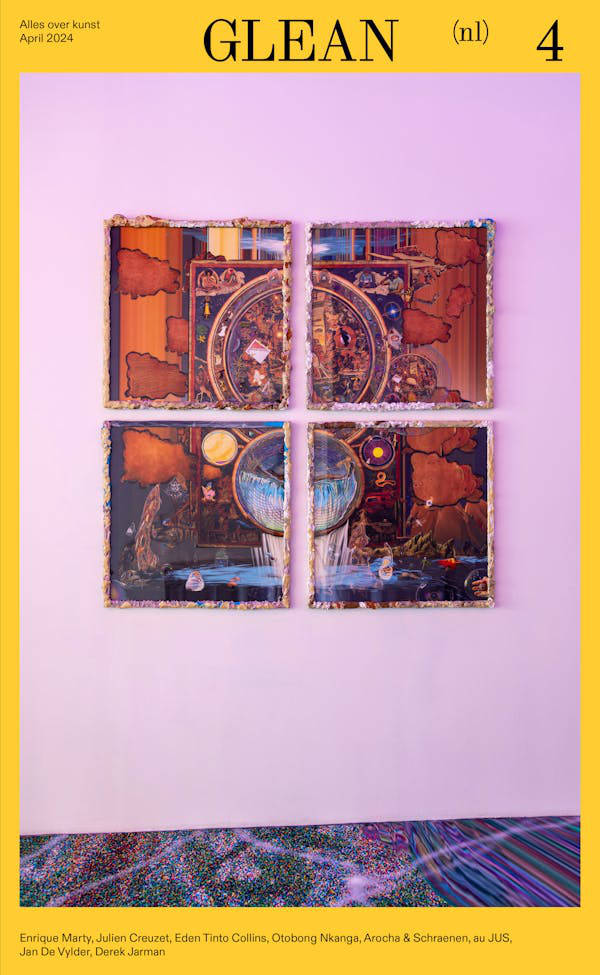
GLEAN - Issue 4 (NL edition)
Enrique Marty, Julien Creuzet, Eden Tinto Collins, Otobong Nkanga, Arocha & Schraenen, au JUS, Jan De Vylder, Derek Jarman

The Lowell Re:Offering - Conjuring the Ghosts of Lowell
A poetic script, an apocalyptic newspaper, and a syntax of intersected historical narratives. An investigation of an archive of writings previously published in The Lowell Offering, a periodical issued between 1840-1845 by women factory workers in Lowell, Massachusetts.
Design by Daria Kiseleva

Errant Journal 6: Debt
Errant Journal No. 6 takes up the topic of debt in order to challenge the idea that it is something rational, natural or inevitable.
The contributions in the issue address the ways in which debt and its language hold power over us and organize obedience; from its role in geopolitics to its associations with shame and guilt through moral and religious connotations. Together they reveal how the personal is always connected to the structural. Crucially, the issue also features contributions that address ways of thinking about debt outside Western/neoliberal hegemony and introduce instances of resistance to the violence and inequality inherent to debt. We’ve made additional space in this issue to address the intensified struggle for Palestinian liberation and its relations to debt/guilt and finance.
Contributors: Ian Beattie, W.E.B. Du Bois, Sultan Doughan, Toon Fibbe, Ibrahim Kombarji, Levi Masuli, Jamie McGhee, Kristina Millona, Bahar Noorizadeh, Falke Pisano, Taring Padi, Dalia Wahdan
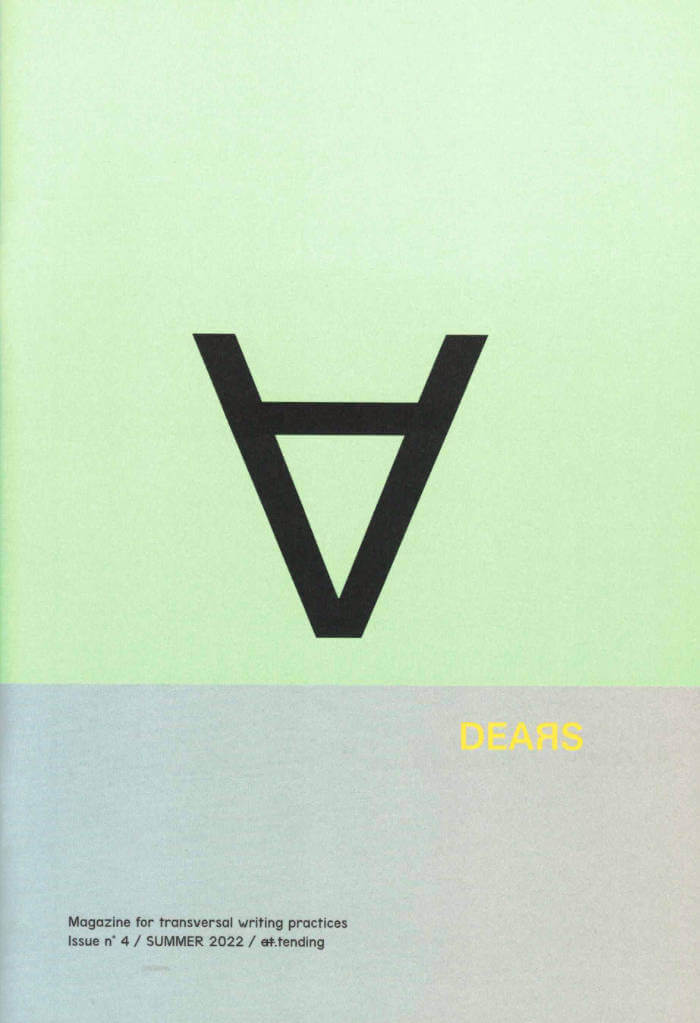
DEARS No. 4 at.tending
Robert Steinberger, Delphine Chapuis Schmitz and 1 more
DEARS is a print magazine for transversal writing practices at the crossroads of art, poetry and experimental writing. It brings together authors and writers from different backgrounds and constitutes a dedicated platform for texts escaping the usual genres and disciplinary boundaries.
DEARS promotes the exploration of new forms of language as a way to foster new forms of living together, and emphasizes the growing relevance of trans- versal writing practices in this respect.
Issue no. 4 / Summer 2022 / at.tending
With texts by Rhoda Davids Abel, Marcelline Delbecq, Egana Dzhabbarly, Camille Kaiser, Alexandra Keramidas, Marianna Maruyama, and an epigraph by Rosi Braidotti.
Editors are Delphine Chapuis Schmitz, Nicole Bachmann and Robert Steinberger.